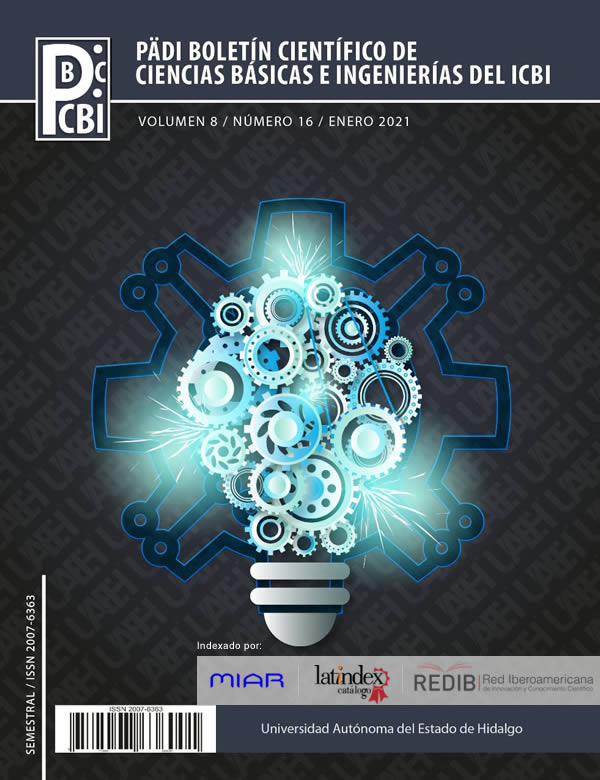Virus that keeps you at home
Abstract
This work presents a simple overview of what viruses are and an explanation of why they can cause damage to host cells. Likewise, the generalities of the SARS-CoV-2 virus are established, which belongs to the RNA viruses; at the start of 2020, this virus has alerted the entire world for its high morbidity; this causes the disease called COVID-19. In particular, the stages of the infection process of the new coronavirus within an organism are described.
Downloads
References
Anthony, S. J., Epstein, J. H., Murray, Kris, A., Navarrete, I., Zambrana, T. C. M., Solovyov, A., Ojeda, F. R., Arrigo, N. C., Islam, A., Ali, K., Shahneaz, 2013. A Strategy to Estimate Unknown Viral Diversity in Mammals. American Society for Microbiology 4(5). DOI: 10.1128/mBio.00598-13.
Ahmed, F., 2008. Profile of Bonnie L. Bassler. Proceedings of the National Academy of Sciences of the United States of America 105(13):4969-4971. DOI: 10.1073/pnas.0705870105.
Backer, J. A., Klinkenberg, D., Wallinga, J., 2020. Incubation period of 2019 novel coronavirus (2019-nCoV) infections among travellers from Wuhan, China, 20-28 January 2020. Euro Surveill 25(5):2000062. DOI:10.2807/1560-7917.ES.2020.25.5.2000062.
Berend, J. B., Ruurd, van der Z., Cornelis, A. M. de H., Peter, J. M. R., 2003. The Coronavirus Spike Protein Is a Class I Virus Fusion Protein: Structural and Functional Characterization of the Fusion Core Complex. Journal of Virology, 77(16): 8801-8811; DOI: 10.1128/JVI.77.16.8801-8811.2003.
Delgado, O. M. I., Hernández, M. J. L. (2015) Los virus, ¿son organismos vivos? Discusión en la formación de profesores de Biología. VARONA, 61: 1-7. URL: https://www.redalyc.org/pdf/3606/360643422007.pdf
Dong, Y., Mo, X., Hu, Y., Qi, X., Jiang, F., Tong, S., 2020. Epidemiological characteristics of 2143 pediatric patients with 2019 coronavirus disease in China. Pediatrics. DOI: https://doi.org/10.1542/peds.2020-0702.
International Committee on Taxonomy of Viruses, 2019. ICTV Master Species List 2019.v1, URL: https://talk.ictvonline.org/files/master-species-lists/m/msl/9601
Lazcano, A. (2015). Origen y evolución de los virus: ¿Genes errantes o parásitos primitivos? En: Mensaje Bioquímico, 34: 73-84 URL: http://metabase.uaem.mx/bitstream/handle/123456789/1471/280_8.pdf?sequence=1
Lee, P., Hu, Y. L., Chen, P. Y., Huang, Y. C., Hsueh, P. R., 2020. Are children less susceptible to COVID-19?. Journal of Microbiology Immunology and Infection S1684-1182(20)30039-6. DOI:10.1016/j.jmii.2020.02.011
Moreira, D., López-García, P. (2009). Ten reasons to exclude viruses from the tree of life. Nature Reviews Microbiology, 7: 306-311. DOI: 10.1038/nrmicro2108
National Institutes of Health. (2020). Coronavirus spike protein structure [Fotografía]. Creative Commons CC BY-NC 2.0 https://search.creativecommons.org/photos/d64c06e0-8828-49d5-bb21-f4f76692a61f
Organización Mundial de la Salud, 2020. Preguntas y respuestas sobre la enfermedad por coronavirus (COVID-19). OMS. https://www.who.int/es/emergencies/diseases/novel-coronavirus-2019/advice-for-public/q-a-coronaviruses#:~:text=sintomas
Renhong, Y., Yuanyuan, Z., Yaning, L., Lu, X., Yingying, G., Qiang, Z., 2020. Structural basis for the recognition of SARS-CoV-2 by full-length human ACE2. Science 367, 1444–1448. DOI: 10.1126/science.abb2762.
Rodríguez-Morales, A. J., Sánchez-Duque, J. A., Hernández-Botero, S., Péres-Díaz, C. E., Villamil-Gómez, W. E., Méndez, C. A., et al. (2020). Preparación y control de la enfermedad por coronavirus 2019 (COVID-19) en América Latina. Acta Medica Peru, 37(1): 3-7. DOI: 10.35663/ amp.2020.371.909
Wan, Y., Shang, J., Graham, R., Baric, R. S., Li, F., 2020. Receptor Recognition by the Novel Coronavirus from Wuhan: an Analysis Based on Decade-Long Structural Studies of SARS Coronavirus. Journal of Virology 94(7). DOI: 10.1128/JVI.00127-20. ISNN: 0022-538X, URL: https://jvi.asm.org/content/94/7/e00127-20
Woolhouse, M., Scott, F., Hudson, Z., Howey, R., Chase, T. M., 2012. Human viruses: discovery and emergence. Philosophical transactions of the Royal Society of London. Series B, Biological Sciences 367(1604):2864–2871. https://doi.org/10.1098/rstb.2011.035













